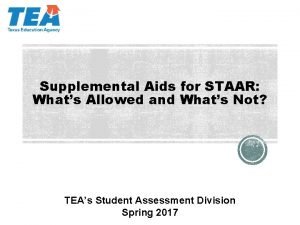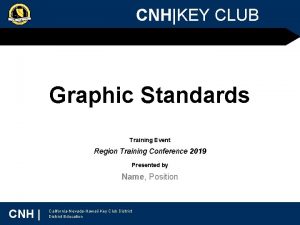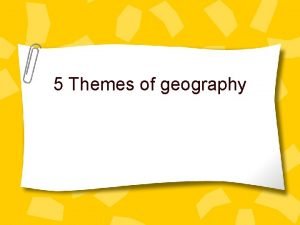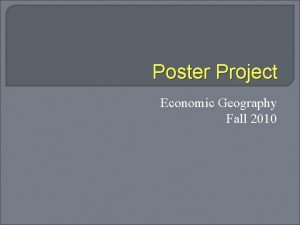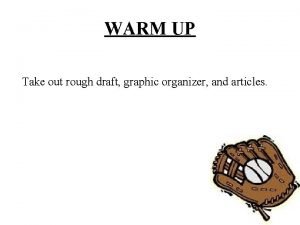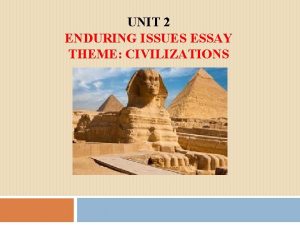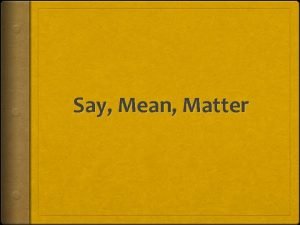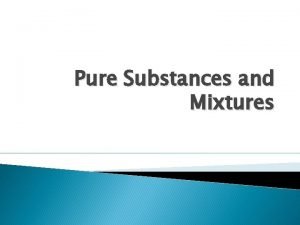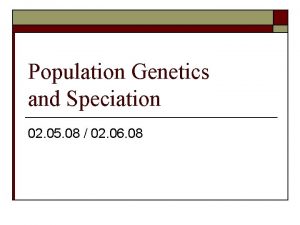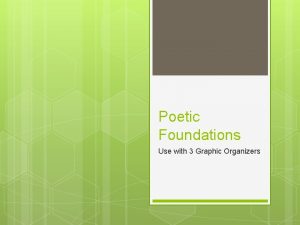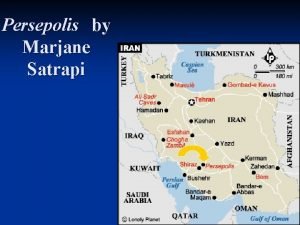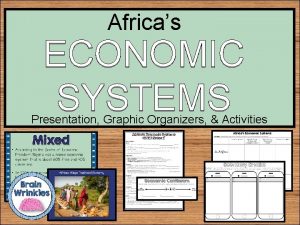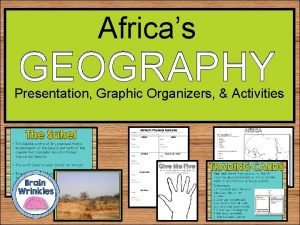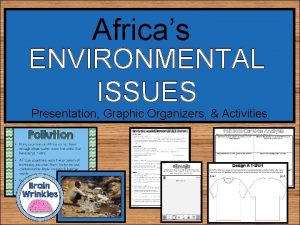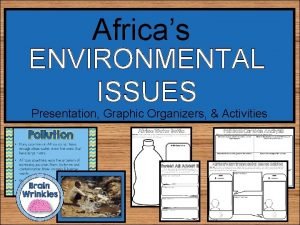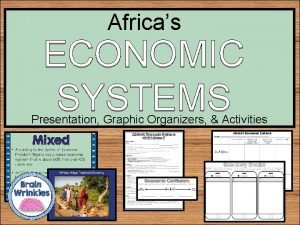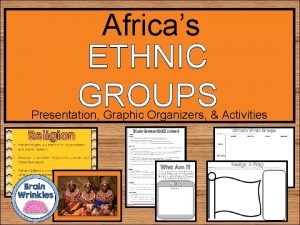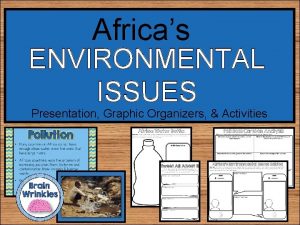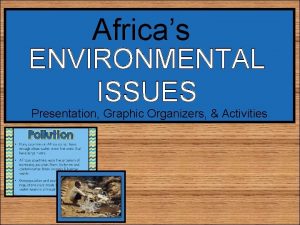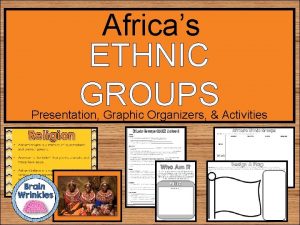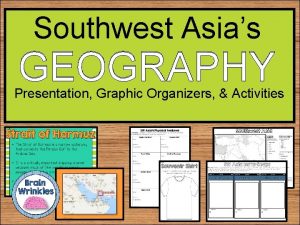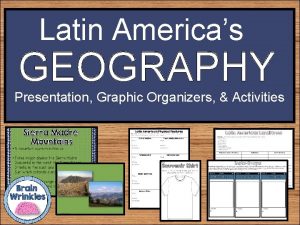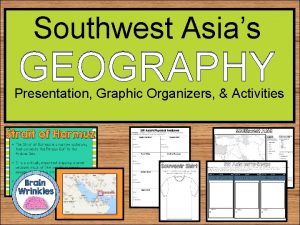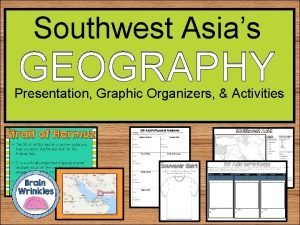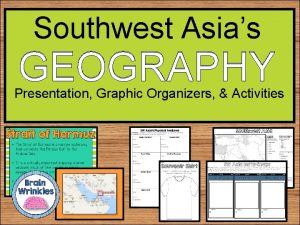Africas GEOGRAPHY Presentation Graphic Organizers Activities STANDARDS SS





































































- Slides: 69

Africa’s GEOGRAPHY Presentation, Graphic Organizers, & Activities

STANDARDS: SS 7 G 1 Locate selected features of Africa. a. Locate on a world and regional politicalphysical map: Sahara, Sahel, savanna, tropical rain forest, Congo River, Niger River, Nile River, Lake Victoria, Great Rift Valley, Mt. Kilimanjaro, Atlas Mountains, and Kalahari Desert. b. Locate on a world and regional politicalphysical map the countries of Democratic Republic of the Congo, Egypt, Kenya, Nigeria, South Africa, and Sudan © Brain Wrinkles

AFRICA I. Political Features: Label the following countries on the map: • Democratic Republic of the Congo • Egypt • Kenya • Nigeria • South Africa • Sudan © Brain Wrinkles

II. Physical Features: Create a map key that includes symbols for: • Rivers • Deserts • Mountains • Lakes • Sahel • Savanna • Rainforest AFRICA Label the following physical features: • Sahara • Sahel • Savanna • Tropical rain forest • Congo River • Niger river • Nile River • Lake Victoria • Great Rift Valley • Mt. Kilimanjaro • Atlas Mountains • Kalahari Desert Draw the symbol for each feature next to the correct label on the map. Color all symbols! © Brain Wrinkles Map Key

Africa’s Geography © Brain Wrinkles

AFRICA • Africa is the world’s second largest continent (11, 700, 000 miles). • It is home to 52 countries, 1, 000 different languages, and 800 million people. • 10% of the world’s population lives in Africa. • The vast African continent has almost every type of landform and climate. • Africa can be divided into several regions, including the Sahara, the Sahel, the savannahs, and the tropical rain forests. © Brain Wrinkles

© Brain Wrinkles

The Sahara • The Sahara is the world’s largest hot desert (3, 500, 000 miles). • It runs across the width of northern Africa and covers 1/3 rd of the continent. • It divides the continent into two distinct regions – North Africa and sub-Saharan Africa. • The Sahara is covered with sand dunes, rocky hills, and stretches of gravel that continue for miles and miles. © Brain Wrinkles

© Brain Wrinkles

© Brain Wrinkles

The Sahara • Very few people live in the desert because it is considered one of the harshest places to live in the world. • The people who do live here are called nomads. • They move from place to place, usually traveling by camel, looking for food & water. © Brain Wrinkles

© Brain Wrinkles

The Sahel • The Sahel is a strip of dry grassland that is located south of the Sahara and north of the equator that separates the desert from tropical rain forests. • The word “Sahel” means “border” or “margin”. • It is a dry, semi-arid region that is slowly turning into desert. • It gets more rainfall than the desert, but still receives very little (ranging from 6 -20 inches). © Brain Wrinkles

© Brain Wrinkles

© Brain Wrinkles

The Sahel • The Sahel is relatively flat with few mountains and hills. • People have tried to live here but generations of overgrazing and desertification have caused soil erosion. • Vegetation is sparse here—grasses and shrubs are unevenly distributed. © Brain Wrinkles

© Brain Wrinkles

Savanna • The African savannas are hot, dry grasslands that are located near the Equator and cover almost half of Africa. • They actually cover the regions just north and south of the rainforests that lie along the equator. • The African savanna is the largest in the world (over 4. 5 million square miles). © Brain Wrinkles

© Brain Wrinkles

© Brain Wrinkles

Savanna • There is a large variety of wildlife in the African savannas, including lions, zebras, & elephants. • Farming is good here, but only if there is good rainfall. • Grasses and grains like wheat, oats, and sorghum grow in the region. • The area receives enough rain to support drought resistant undergrowth, but not enough to support forest-type vegetation. • Grasses are tall and thick, while trees are short and scattered. © Brain Wrinkles

© Brain Wrinkles

© Brain Wrinkles

Tropical Rain Forest • Africa’s tropical rain forest is located along the central coast of Africa, near the Equator, and lies in the Congo River Basin. • The rain forest covers 1/5 th of the land surface of Africa and touches 37 countries. • The rain forest has a hot, humid climate with an annual rainfall of over 17 feet. © Brain Wrinkles

© Brain Wrinkles

© Brain Wrinkles

Tropical Rain Forest • Africa’s tropical rain forest is home to a large variety of animals. • Trees are so thick and tall that sunlight never reaches the forest floor! • The trees grow hundreds of feet tall. • It’s the second largest rain forest in the world; the Amazon rain forest in Brazil is the largest. • Unfortunately, about 90% of this rain forest has shrunk due to deforestation. © Brain Wrinkles

© Brain Wrinkles

© Brain Wrinkles

Congo River • The Congo River is located in west central Africa. • It begins in central Africa, near Lake Tanganyika, and flows west. • It crosses the equator twice and is surrounded by rainforest. © Brain Wrinkles

© Brain Wrinkles

© Brain Wrinkles

Congo River • The Congo River is the second longest river in Africa and the fifth longest in the world. • It’s over 3, 000 miles long. © Brain Wrinkles

© Brain Wrinkles

Niger River • The Niger River is located in western Africa. • It flows through Guinea, Mali, Niger, Benin, & Nigeria. • The Niger River is the third largest river in Africa. • It runs over 2, 600 miles. © Brain Wrinkles

© Brain Wrinkles

Niger River • The mouth of the Niger River flows through a large delta, often referred to as the “Oil Delta” because of the petroleum industry that’s centered here. © Brain Wrinkles

© Brain Wrinkles

Nile River • The Nile River is located in eastern Africa. • It starts in the mountains of central Africa and flows northward through eastern Africa and empties into the Mediterranean Sea. • The Nile is the world’s longest river at 4, 150 miles. © Brain Wrinkles

© Brain Wrinkles

© Brain Wrinkles

Nile River • The Nile River provides water for Sudan and Egypt. • It’s an important waterway for transporting people and goods. • The Nile also provides a source of irrigation for agriculture. © Brain Wrinkles

© Brain Wrinkles

© Brain Wrinkles

Lake Victoria • Lake Victoria is the largest lake in Africa and the second largest freshwater lake in the world. (Lake Superior is the largest. ) • It is located in central Africa and extends into three countries: Tanzania, Uganda, and Kenya. • Lake Victoria is a headwaters reservoir for the Nile River. © Brain Wrinkles

© Brain Wrinkles

© Brain Wrinkles

Lake Victoria • Even though it is shallow, Lake Victoria is vital in supporting the millions of people that live nearby. • It provides a living for many fishermen and attracts millions of tourists each year. © Brain Wrinkles

© Brain Wrinkles

Great Rift Valley • The Great Rift Valley is a giant dip in the Earth’s surface. • It was created about 35 million years ago when the African and Eurasian tectonic plates separated. • The valley runs north to south for over 3000 miles, from Syria in Southwest Asia to Mozambique in east Africa. © Brain Wrinkles

© Brain Wrinkles

Great Rift Valley • The Great Rift Valley varies in width from about 20 to 60 miles. • The valley is surrounded by highlands. • It contains three of Africa’s most important lakes: Lake Victoria, Lake Tanganyika, and Lake Malawi. © Brain Wrinkles

© Brain Wrinkles

© Brain Wrinkles

Mt. Kilimanjaro • Mt. Kilimanjaro is the tallest mountain in Africa. • It is located in Tanzania and rises approximately 16, 100 feet at its base to 19, 340 feet above sea level. • The mountain is actually a dormant volcano. © Brain Wrinkles

© Brain Wrinkles

© Brain Wrinkles

Mt. Kilimanjaro • Mt. Kilimanjaro is part of the Kilimanjaro National Park and is a major climbing destination. • The first climbers proven to have reached the summit of the mountain were Hans Meyer and Ludwig Purtscheller in 1889. © Brain Wrinkles

© Brain Wrinkles

Atlas Mountains • The Atlas Mountains are a mountain range in north Africa. • The mountains extend from Morocco to Tunisia, between the Mediterranean Sea and the Sahara desert. • They separate the northern coastal regions from the Sahara Desert. © Brain Wrinkles

© Brain Wrinkles

© Brain Wrinkles

© Brain Wrinkles

Kalahari Desert • The Kalahari Desert is a large arid to semi -arid sandy area that’s located in southwestern Africa. • It covers parts of Botswana, Namibia, and South Africa. • Its dunes range from 20 to 200 feet high and can be 50 miles long. • The region is surrounded by semi-arid areas that are slowly becoming more dry due to desertification. © Brain Wrinkles

© Brain Wrinkles

© Brain Wrinkles

Kalahari Desert • The Kalahari Desert is not a “true” desert because it receives 3 -10 inches of rain per year. • Because of the precipitation and underground water supplies, grass, shrubs, and wild animals manage to live in the Kalahari desert. © Brain Wrinkles

© Brain Wrinkles

© Brain Wrinkles
 Whats africas largest lake
Whats africas largest lake Tea supplemental aids
Tea supplemental aids Pictorial models of geometric figures with no labels
Pictorial models of geometric figures with no labels Tea approved supplemental aids
Tea approved supplemental aids Hierarchical graphic organizer
Hierarchical graphic organizer Universal accommodations for mcas
Universal accommodations for mcas Time pattern organizer example
Time pattern organizer example Staar grammar and mechanics rules
Staar grammar and mechanics rules Marzanos strategies
Marzanos strategies Mcas graphic organizer
Mcas graphic organizer Graphic weight examples
Graphic weight examples Ghost graphic story graphic and wayfinding
Ghost graphic story graphic and wayfinding Cues, questions, and advance organizers
Cues, questions, and advance organizers Model advance organizer
Model advance organizer Expository advance organizers examples
Expository advance organizers examples Dear organizers
Dear organizers Discourse analysis and vocabulary
Discourse analysis and vocabulary Cues questions and advance organizers
Cues questions and advance organizers Cues questions and advance organizers
Cues questions and advance organizers Skimming advance organizer examples
Skimming advance organizer examples Cnh graphic standards
Cnh graphic standards Cnh graphic standards
Cnh graphic standards Cnhkeyclub
Cnhkeyclub Operating activities vs investing activities
Operating activities vs investing activities Indoor and outdoor sports
Indoor and outdoor sports Support activities and primary activities
Support activities and primary activities Examples of primary activities
Examples of primary activities 5 themes of geography graphic organizer
5 themes of geography graphic organizer Tertiary activities in geography
Tertiary activities in geography Factors determining service standards
Factors determining service standards Presentation about free time activities
Presentation about free time activities Sqa understanding standards advanced higher geography
Sqa understanding standards advanced higher geography Mission geography definition
Mission geography definition Sqa advanced higher english understanding standards
Sqa advanced higher english understanding standards Frq ap human geography format
Frq ap human geography format 5 themes of geography ap human geography
5 themes of geography ap human geography Stateless nation
Stateless nation Geography poster project
Geography poster project Pedestrian count data presentation
Pedestrian count data presentation Sinciput presentation
Sinciput presentation Vertex presentation
Vertex presentation Rise of dictators graphic organizer
Rise of dictators graphic organizer Economic system graphic organizer
Economic system graphic organizer Graphic communications definition
Graphic communications definition Schkin
Schkin Rough draft graphic organizer
Rough draft graphic organizer Study of energy and its transformations
Study of energy and its transformations Tpr recording
Tpr recording Enduring issues essay graphic organizer
Enduring issues essay graphic organizer Pregnancy and fetal development brainpop answers
Pregnancy and fetal development brainpop answers Chapter 14 theories of personality
Chapter 14 theories of personality Examples of quote sandwiches
Examples of quote sandwiches Pullman strike graphic organizer
Pullman strike graphic organizer Medias res
Medias res Creating a dinosaur sculpture type of graphic organizer
Creating a dinosaur sculpture type of graphic organizer Graphic practice
Graphic practice Say, mean matter sentence starters
Say, mean matter sentence starters Say mean matter examples
Say mean matter examples Ricas math
Ricas math Rhode island
Rhode island Examples of graphic sources
Examples of graphic sources Tbear writing
Tbear writing Mixtures images
Mixtures images Evolution graphic organizer
Evolution graphic organizer Poetry graphic organizer
Poetry graphic organizer Persepolis graphic novel
Persepolis graphic novel Graphic novel terms and concepts
Graphic novel terms and concepts Graphic rating scale
Graphic rating scale Potential rating scale appraisal problems
Potential rating scale appraisal problems Forced distribution method example
Forced distribution method example







